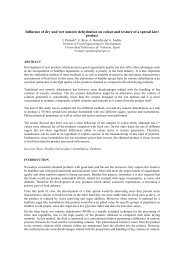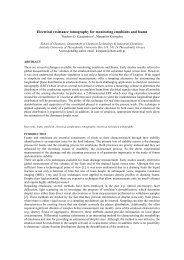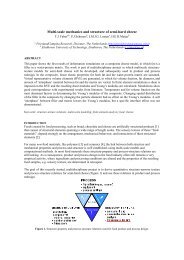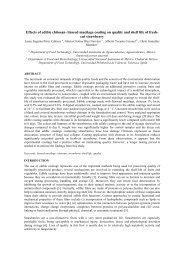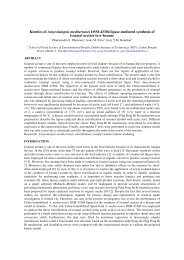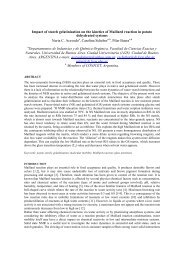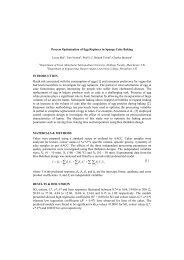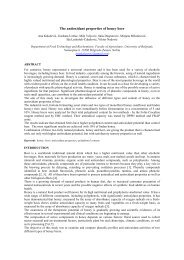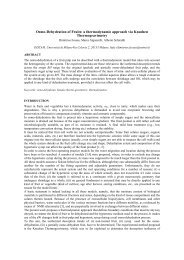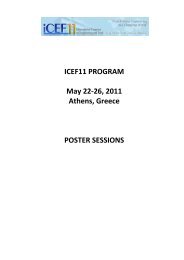Linseed Mucilage and Chitosan composite films - 11th International ...
Linseed Mucilage and Chitosan composite films - 11th International ...
Linseed Mucilage and Chitosan composite films - 11th International ...
You also want an ePaper? Increase the reach of your titles
YUMPU automatically turns print PDFs into web optimized ePapers that Google loves.
Flaxseed gum is commercially feasible only as a by-product of the linseed oil industry therefore preparation<br />
methods of gum are based on oil meal or oil meal cake [7]. Flaxseed gum is a heterogeneous polysaccharide<br />
composed of xylose, arabinose, glucose, galactose, galacturonic acid, rhamnose <strong>and</strong> fucose [8]. Flaxseed gum is a<br />
hydrocolloid with good water-holding capacities, owing to its marked swelling capacity <strong>and</strong> high viscosity in<br />
aqueous solution [8]. Functionally, flaxseed gum resembles gum arabic more closely than the other common<br />
gums, so that it has been suggested to replace gum arabic in emulsions [7]. Flaxseed gum also exhibits ‘‘weak<br />
gel’’-like properties that can be used to replace most of the non-gelling gums for food <strong>and</strong> non-food applications<br />
[9].<br />
MATERIALS & METHODS<br />
<strong>Mucilage</strong> was extracted from linseed in a proportion 1:5 with deionized water at 40°C for 1h <strong>and</strong> 1400 rpm.<br />
Formulations, FA, FB <strong>and</strong> FC, were made by 100, 70 <strong>and</strong> 80 mL of mucilage <strong>and</strong> they were solubilized in<br />
distilled water to complete 100 mL. Lactic acid was added at 0.5% (v/v) <strong>and</strong> agitated for 30 minutes, chitosan at<br />
1% (w/v) <strong>and</strong> after 24 hours, glycerol at 0.3% (v/v). pH’s formulations (FA, FB <strong>and</strong> FC) were: 4.5, 4.3 <strong>and</strong> 4.4<br />
<strong>and</strong> water activity: 0.9945, 0.9965 <strong>and</strong> 0.9970. Formulations were pasteurized <strong>and</strong> filtered. Each formulation was<br />
poured in Petri dishes completing 20 g <strong>and</strong> dried in a stove at 40°C during 24 hours. Solids <strong>films</strong> were set with<br />
silica gel for a day.<br />
Optical properties<br />
Each film specimen was cut into a rectangular piece, thickness was measured in three points of the <strong>films</strong> <strong>and</strong><br />
these were equilibrated at 50% RH for a day before placing them in a spectrophotometer test cell. Measurements<br />
were performed using air as the reference. The light transmittance of the <strong>films</strong> was scanned from wavelength of<br />
300 to 700nm using a GBC spectrophotometer. The measurement was done in triplicate <strong>and</strong> the average of three<br />
spectra was calculated. The transparency at 600nm (T 600 ) was obtained from the following equation [10]:<br />
T 600 =(log %T)/b (1)<br />
where %T is percentage transmittance <strong>and</strong> b is the film thickness (mm). The opacity of the <strong>films</strong> was calculated<br />
by the following equation according to the method described by [11]: Opacity = absorbance at 500nm × film<br />
thickness<br />
The color of the film was assessed using a colorimeter (Minolta, CR-400). A white st<strong>and</strong>ard color plate (L =<br />
96.9379, a = -0.1121, b = 2.3085) for the instrument calibration was used as a background for color<br />
measurements of the <strong>films</strong>. The system provides the values of three color components; L* (black-white<br />
component, luminosity), <strong>and</strong> the chromaticness coordinates, a* (+red to −green component) <strong>and</strong> b* (+yellow to<br />
−blue component). Hunter L*, a*, <strong>and</strong> b* values were averaged from six readings across for each film, <strong>and</strong> then<br />
the total color difference (∆E*) was calculated using the following equation [12]: ∆E* = [(∆L*) 2 + (∆a*) 2 +<br />
(∆b*) 2 ] 0.5 where ∆L*=L*−L 0 *, ∆a*=a*−a 0 *, ∆b*=b*−b 0 *, where L 0 *, a 0 * <strong>and</strong> b 0 * are color values for control<br />
<strong>films</strong> <strong>and</strong> L*, a* <strong>and</strong> b* are color values for FA, FB <strong>and</strong> FC <strong>films</strong> containing chitosan. Films were equilibrated at<br />
75% HR.<br />
A modification of the ASTM E96-95 gravimetric method for measuring water vapour permeability (WVP) of<br />
flexible <strong>films</strong> was employed, using Payne permeability cups (Elcometer SPRL). Deionised water was used inside<br />
the testing cup to achieve 100% relative humidity on one side of the film through a circular opening of 3.5 cm in<br />
diameter. Once the <strong>films</strong> were placed in the cups. The environment within the cabinets was held at constant RH<br />
using over-saturated NaCl solution. The cabinets were placed at controlled temperature of 20ºC. During WVP<br />
testing, the side of the film in contact with the PTFE plate was placed in contact with that part of the test cup<br />
having the highest relative humidity. The cups were weighed periodically after steady state was reached using an<br />
analytical balance (±0.0001 g). Water vapour permeability was determined from the slope obtained from the<br />
regression analysis of weight loss data as a function of time, once the steady state was reached. The method



